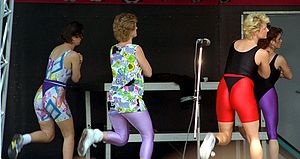Introduction:
Arthritis is becoming more and more common — and not just among the very old. That’s the bad news. The good news is that a program of moderate exercise can reduce pain and improve mobility for many of the over 40 million individuals with this degenerative disease.
Now What is Arthritis?
Arthritis means inflammation of a joint. Osteoarthritis, the most common form of arthritis, is characterized by a progressive loss of cartilage. This degenerative disease is usually limited to a specific area, such as the knees, hips or spine. Common symptoms include joint pain, limited range of motion, and swelling. Rheumatoid arthritis, which is far less common, causes the inner linings of the joints to become inflamed.
How Can Exercise Help?
For many years, doctors have recommended that patients with arthritis engage in flexibility training to help improve range of motion and reduce some of the stiffness in their afflicted joints. In recent years, doctors have also begun to recognize the benefits of cardiovascular exercise and strength training. Not only does a wellrounded exercise program preserve joint range of motion and flexibility but it also reduces the risk of cardiovascular disease, increases joint stability, and lessens the physical and psychological pain that often accompanies a diagnosis of arthritis.
Exercise and rest:-
People with arthritis often have to balance carefully how and when to exercise and when to rest.
In adults, if the joints are particularly inflamed or swollen it may be necessary to rest more than usual. But generally, people with arthritis should exercise every day to prevent joints becoming stiff and painful, and to keep muscles strong.
For children with arthritis, it’s particularly important to exercise even when the disease is very active, because contractures and deformities can develop very quickly.
People with arthritis need three forms of exercise:–
1.General exercise for health
Any exercise that leaves you feeling a little breathless and your muscles slightly tired is good for you. As well as keeping you mobile it can help you relax, make you feel better about yourself and give you more energy.
When exercising, it’s best to use as much of the body as possible – swimming, walking and cycling are all good options. Swimming has the added advantage that the water supports the weight of your body rather than your joints. Some strokes may not suit you, though, so try to get professional advice.
If you go to exercise classes, check they’re run by a qualified teacher and that the teacher knows about your condition.
2.Mobilising exercises
People with arthritis need to keep their joints moving. Bending and straightening exercises, gentle pedalling or swimming can help a lot. Your physiotherapist may recommend hydrotherapy at your local hospital: many people find they move more freely in water and the warmth of the water loosens their joints.
3.Special exercises to strengthen muscles
If your muscles are strong and healthy, they protect your joints better and you may feel less pain. Your physiotherapist will be able to give you a series of muscle-strengthening exercises to perform at home. Swimming and hydrotherapy are also effective ways of strengthening as well as mobilising.
Exercise checklist for People with arthritis:-
Do the following:
•Choose exercises suitable to your level – if you’re a beginner, work up gradually
•Do gentle warm-up stretches before and after the exercise
•Wear good footwear and appropriate clothing
•Enjoy yourself
Don’t do the following:
•Binge on exercise – little and often is better
•Continue with an activity if it makes your pain worse
•Do fitness or aerobic exercises on a stone or concrete floor
•Exercise if you feel ill
You may click to see :-
Some Basic Movements In Yoga Exercise:
Top Three Types of Exercises for Artherities:
Disclaimer: This information is not meant to be a substitute for professional medical advise or help. It is always best to consult with a Physician about serious health concerns. This information is in no way intended to diagnose or prescribe remedies.This is purely for educational purpose.
Resources:
http://www.bbc.co.uk/health/physical_health/conditions/in_depth/arthritis/treatmentarthritis_exercise.shtml
http://www.acefitness.org/fitfacts/fitfacts_display.aspx?itemid=22
http://www.afarewellrescue.com/exercise-and-arthritis/

http://www.healthyexerciseworld.com/exercise-for-arthritis.html
Related articles
- What hand exercises can help minimize the effects of arthritis? (zocdoc.com)
- If you’re feeling knee pain, get it checked out (charlotte.news14.com)
- Exercise Is Key for People with Arthritis (nlm.nih.gov)
- Natural Arthritis Therapy (healthadvisory.typepad.com)
- An All Natural Approach for Arthritis Pain (healthadvisory.typepad.com)
- Today Is World Arthritis Day (zocdoc.com)
- Knee and Hip Exercises for Osteoarthritis (webmd.com)
- Using Natural Way Therapy For Arthritis (beauteclairereallywork.typepad.com)
- Exercising During a Flare Up of Osteoarthritis (brighthub.com)
- Why is my arthritis affected by the weather? (zocdoc.com)

